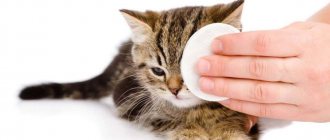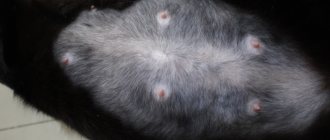The cat has scabs on its body: Preface
As a rule, domestic cats, like wild cats, live on their own and do not particularly like it when their owners invade their lives and personal space. The owner’s task is to feed and clean the litter box, but this is only in the opinion of the cats themselves.
In fact, owners are always concerned about the health of their cats. But spotting skin problems is more difficult than in dogs. Cats, unlike dogs, are not washed every day after a walk, and are brushed only during the period of shedding and long-haired pets.
Therefore, dermatological problems in cats are most often noticed in an advanced form. We will talk further about why a cat has scabs on its body.
Watch the video: Is your cat itching? Causes of itching - advice from a veterinarian
Allergic skin diseases
Allergic reactions are a consequence of an inadequate response of the cat's immune system to foreign substances entering the body. The cause of an allergy can be anything: a certain component of food, household chemicals, plant pollen, synthetic fabrics, dust in the house, etc. When exposed to an allergen, skin hyperemia, inflamed areas, severe itching, hair loss and increased body temperature are observed.
Important. Long-term exposure to an allergen is fraught with the development of atopic dermatitis, eosinophilic granuloma and asthmatic syndrome.
Therapy for allergic reactions includes taking antihistamines to relieve itching, hormonal agents and antibiotics if urgently needed. To alleviate the pet's condition, medicated shampoos and decoctions of medicinal herbs are used.
The cat is itchy and covered in sores: Diseases
Flea dermatitis
The first and most important cause of all dermatological problems is fleas. Despite the fact that cats do not walk, do not go outside or even into the entrance, they must be treated for fleas as regularly as dogs.
Since fleas most often live under floors, in furniture, under skirting boards and thresholds, and they only come to the animal to dine. When we see fleas on a cat’s body with the naked eye, this is an extreme degree of infection.
The main signs of allergic flea dermatitis are:
- various wounds, sores, scabs on the cat’s body;
- active licking. It is one of the ways cats “scratch”;
- frequent scratching of the entire body.
What should be done in this case? Carry out regular antiparasitic treatments with high-quality products. These can be drops applied to the withers: Bravecto , Inspector, Advantage, Advocate, Frontline.
There are drops of lower quality and less expensive, they can also be used, but with caution, since they usually have more side effects: these can be Dana Ultra, Bars, Celandine drops.
But not only fleas can cause various sores on the body. Another option is often different types of ticks.
See what anti-allergy foods you can buy
Sarcoptic mange
This disease is caused by sarcoptoid mites that live under the pet's skin. In the initial stages, it is characterized by small bald patches and dandruff, so the owners do not notice changes in the fur, but notice that the cat is suffering from itching, tearing its body with its claws.
Scabs begin to appear on the face, near the ears, around the eyes and gradually fill the entire body. The cat constantly suffers from itching, often stops eating, becomes aggressive and tired.
It is worth remembering that treatment for this disease is mandatory! Because it can cause unpleasant symptoms in people with weakened immune systems.
Symptoms of sarcoptic mange:
- The very first symptom is that the cat began to scratch its ears often. This is explained by the fact that the mite initially settles on the outside of the ears and only then spreads to the eyelids, skin of the face, and abdomen;
- the affected areas become covered with unsightly gray or dirty green scabs;
- the skin begins to crack;
- In the most affected areas, pustular capsules form, which burst, the contents spread throughout the body and cause even greater infection and secondary infections.
How to learn to understand your cat? Is your cat being naughty and you can’t find an approach to it? Read!
Treatment of sarcoptic mange:
A proper diagnosis requires a visit to a veterinary dermatologist. If one is not available, then a general practitioner will help. The veterinarian will take a scraping and see this type of tick under a microscope.
It is similar to demodex and otodex, but has differences. This disease is easily treated. A veterinarian may prescribe a rather outdated, but time-tested drug with ivermectin ( Ivermec ) in the form of injections.
But it has many contraindications and side effects. There are also more modern acarcidal drugs that are easily tolerated by animals and are prescribed by veterinarians.
Most owners are concerned with the question of how to avoid re-infection. First of all, it is necessary to carry out high-quality treatment of the home: throw away, or better yet, burn, bedding and toys, boil bowls and toys, or use specialized disinfectants that act on ticks.
The cat has small sores all over her body: Acne in cats?
There is another relatively harmless cause of small sores on the body, most often on the chin - acne. Yes, yes, acne not only torments teenagers, but also interferes with the lives of our four-legged friends.
Acne are small black spots on a cat's chin. There are many myths associated with them. The main thing is that it comes from low-quality plastic bowls. But this is absolutely not true. Bowls have nothing to do with this problem.
If the owner notices black spots on the cat's chin, then it is necessary to visit a veterinary dermatologist to make sure that the cat does not have fungus or flea dermatitis.
Next, you should purchase a bandage and salicylic alcohol at a regular human pharmacy and wipe the cat’s chin several times a day with a bandage soaked in salicylic alcohol.
You also need to pay attention to the cat's diet. Most likely, he is very fatty for an animal. This is precisely why this problem appears.
Call the doctor
Endoparasites
If you notice your pet constantly wanting to scratch a bare area, this may indicate the presence of endoparasites. For example, scratching with teeth or claws may occur in an animal due to unpleasant flea bites. In order to relieve the animal from unpleasant sensations, special solutions, sprays and drops for the withers are used. Treatment must be carried out several times in order to remove not only adult individuals from the fur, but also newly hatched larvae.
Of all the internal organs, the intestines are the most susceptible to parasite penetration. Antihelmintic drugs are excellent for removing worms from the body. However, if the case is advanced (for example, when infected with large worms), the cat may need surgical intervention.
You might be interested in: What could cause a swelling of the lower lip in a cat?
Ear mites can be treated with drops and proper care for your pet. You will need to remove him from contact with stray animals and prohibit him from eating rodents and wild birds.
The cat has sores on her body: Demodectic mange
Another common cause of body sores in cats is demodicosis. This is a tick, called subcutaneous because of its location. Demodex, which is the name of the causative agent of this disease, affects all cats and dogs, regardless of age and breed.
Modern veterinarians believe that demodex activity is caused by:
- weakened immunity (due to recent illnesses, chronic and congenital changes and diseases);
- poor quality maintenance (untimely cleaning of the tray, dirty house and bedding, dampness in the room, dirt);
- unbalanced diet (lack of fat and vitamin A in the diet).
Alarm clock cat. How to wean your pet from the habit of waking up? Pet harm is treatable! The best lifehacks are here:
Diagnosis and treatment of demodicosis:
First of all, the cat's fur loses its shine and becomes brittle, the skin around the eyes is affected, it turns red, begins to peel, and dandruff appears. Next, dandruff and flaking become coarser and crusty.
The cat develops scabs all over its body, which become rougher over time, begin to burst and secondary infections join them, and ulcers may appear. From this moment on, the animal may begin to itch, but itching is not a mandatory sign of demodicosis.
To make a correct diagnosis, a mandatory visit to a veterinary dermatologist is required, who will scrape and pluck the hairs from the cat. After examining them under a microscope and confirming the diagnosis, treatment will be prescribed.
In dogs, this disease is treated with the Bravecto tablet. For cats there are Bravecto Spot-On drops . Using them three times according to a specific schedule completely and safely rids the cat of uninvited guests.
The cat has itchy sores on its body: Notoedrosis
In addition to Demodex, cats can become infected with mites that cause scabies; its causative agent is the microscopic mite Notoedres cati. Adults of this type of tick, when they come into contact with a pet’s skin, gnaw holes up to two centimeters deep, feeding on blood and skin cells.
Females, getting under the skin, lay eggs and die. After another one and a half to two months, almost the entire surface of the animal’s skin is affected (Not to be confused with ear mites! We have a separate article ).
This causes severe itching, the cat becomes aggressive, stops feeding, weakens and dies after 2-5 months. Owners should also be frightened by the fact that upon contact with an infected animal, human infection occurs.
Fortunately, this type of mite cannot live and reproduce on humans for a long time, so it only causes local allergic reactions in the form of hives and itching. After death or destruction of all individuals, these symptoms disappear on their own.
The disease is most dangerous for weakened individuals, kittens and young animals. They die without timely treatment. Animals become infected through direct contact with already sick animals. Therefore, epidemics of notoedrosis are most common among homeless animals living in groups, in shelters and nurseries.
To diagnose this disease, only a scraping is required. Next, the doctor prescribes treatment. As in the previous case, notoedrosis is treated with the use of Bravetco Spot-On drops.
It is not yet available in all cities, so many veterinary dermatologists still use drugs containing toxic ivermectin. Its use is not always advisable on emaciated and weakened animals, and then drugs based on selamectin can be used.
The safest drug, with the exception of Bravecto Spot-On, is considered to be Advocate drops, sold in almost all veterinary pharmacies.
Watch the video: Veterinarian lifehacks - Skin diseases in cats and their symptoms
Diagnostic techniques
Diagnosis is made through visual examination of the skin. The specialist must understand at what stage the development of the disease is, and also make an assumption about what exactly could have caused its appearance. The owner must give the specialist as complete information as possible about when and after what something wrong happens to the pet.
Monitoring symptoms (itching, rashes, peeling, frequency of new blisters) is of important diagnostic importance But identifying external signs of the disease is only half the battle. First, the doctor (if possible) must determine whether the pathology has occurred in your pet’s closest relatives. Secondly, and even more important, it is necessary to establish whether pathogenic and conditionally pathogenic microflora (and this almost always happens), and also to identify its exact type. The diagnosis is made, as a rule, in the presence of three or more symptoms characteristic of atopic dermatitis.
A cat has sores on its body: How will the doctor treat it?
Any skin sores in cats require an urgent visit to a veterinary dermatologist. These are not available in all clinics; in this case, a general practitioner will also help.
The main actions that will be carried out by him:
- visual inspection of the animal;
- survey of owners about the maintenance, treatment, and nutrition of the animal;
- scraping from affected areas;
- if necessary, clinical blood tests.
A hospital for the animal may also be offered. This is due to the fact that in the first day after the use of acarcidal drugs, the animal’s condition can sharply worsen due to poisoning by the decay products of dead ticks.
How to wash a cat and whether to wash it at all? Almost Hamlet's question! Does your pet need a bath? Let's read!










